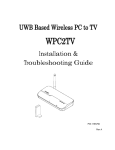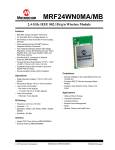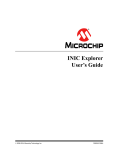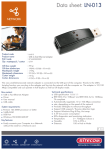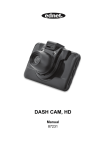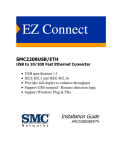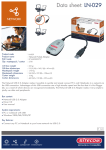Download USB 3.0 to HDMI® Display Adapter User's Manual
Transcript
USB 3.0 to HDMI Display Adapter User's Manual ® 2 Table of Contents Safety instructions ................................................................. 4 Copyright................................................................................. 5 Trademarks ............................................................................. 5 Introduction............................................................................. 5 Features................................................................................... 6 Application .............................................................................. 6 Package contents ................................................................... 7 System requirement ............................................................... 8 Specifications ....................................................................... 10 Product overview.................................................................. 12 Connection ............................................................................ 13 Installation and preparation ............................................... 15 ® - For Windows 7 user ........................................................... 15 ® - For Windows Vista user ..................................................... 21 ® - For Windows XP user ........................................................ 27 Using the adapter ................................................................. 36 - Extended mode .................................................................. 36 ® - Mirror the Windows desktop .............................................. 44 - Be the primary monitor ........................................................ 45 Adjusting resolution and refresh rate ................................ 47 Standby and hibernate, shut down and restart ................. 49 Using dual adapters ............................................................. 50 Disconnecting the adapter .................................................. 50 Uninstall the adapter and driver.......................................... 51 Troubleshooting ................................................................... 52 Regulatory compliance ........................................................ 55 - FCC conditions .................................................................... 55 - CE ...................................................................................... 55 - WEEE information ............................................................... 55 3 ® This manual is designed for use with the USB to HDMI Adapter. Information in this document has been carefully checked for accuracy; however, no guarantee is given to the correctness of the contents. The information in this document is subject to change without notice. The manufacturer does not make any representations or warranties (implied or otherwise) regarding the accuracy and completeness of this document and shall in no event be liable for any loss of profit or any commercial damage, including but not limited to special, incidental, consequential, or other damage. Before attempting to connect, operate or adjust this product, please save and read the User's Manual completely. The style of the product shown in this User's Manual may be different from the actual unit due to various models. Safety instructions Always read the safety instructions carefully: ■ Keep this User’s Manual for future reference ■ Keep this equipment away from humidity ■ If any of the following situation arises, get the equipment checked by a service technician: • The equipment has been exposed to moisture. • The equipment has been dropped and damaged. • The equipment has obvious sign of breakage. • The equipment has not been working well or cannot get it to work according to the User’s Manual. 4 Copyright This document contains proprietary information protected by copyright. All right are reserved. No part of this manual may be reproduced by any mechanical, electronic or other means, in any form, without prior written permission of the manufacturer. Trademarks All trademarks and registered trademarks are the property of their respective owners or companies. Introduction ® The USB3.0 to HDMI Display Adapter enables you to display your content to two different screens which support ® HDMI output. If you need to view three different kinds of content at the same for the multi-task working, no need to add extra graphic card on the desktop with this adapter. It’s more convenience and flexible to utilize the adapter on both desktop and laptop. 5 Features ■ Add-on monitor, LCD or projector through a single USB 3.0 port ■ Backward compatible with USB 2.0 Standard ■ Hot-plug; add or remove monitor without system reboot ® ■ Small in size, works with all HDMI displays ■ Supports High Resolution up to 2048 x 1152 ■ Extend and Mirror mode support ■ Resumes from hibernation and suspend modes ■ Supports up to 6 USB display adapter to work simultaneously Application Office workstation ■ View your large spreadsheets across two screens with display continuity ■ Multitask more effectively without overlapping windows ■ Edit on one screen while surfing the Internet information on the other On the road ■ Do multiple screen presentations without bringing another computer ■ Easily provide multiple screen exhibitions in a trade show Graphics workstation ■ Use second display for palettes/tools ■ Get a panoramic view of large documents 6 Editing workstation ■ Type documents on one screen while viewing reference material on the other ■ Compare two documents simultaneously across two screens Financial analysis ■ Have one monitor per data stream ■ View charts and live data at the same time Entertainment ■ View videos/TV on one screen and reviews on the other ■ Get additional perspectives when playing games Package contents ® ■ USB 3.0 to HDMI Adapter x1 ■ CD (Driver & User’s Manual) x1 ■ USB cable x1 ■ Quick installation guide 7 System requirement Hardware ■ The minimum requirements for the PC are: - With Single Core CPU at 1.2GHz or higher processor ® ® ® ® ® clock. Intel Pentium /Celeron family, or AMD K6 ® ® /Athlon /Duron family, or compatible processor - 512MB memory - At least one USB2.0 port - 30Mb of available disk space - Super VGA (800 x 600) or higher resolution monitor ■ To play DVD on the adapter-attached monitor, except the requirements above, the following requirements should also be met: - With dual core CPU at 2.0 GHz processor clock - The adapter screen resolution be set to 800x600 with 32bit color. It is recommended to close all other unnecessary applications if the video playback is not smooth. ■ For 1-2 monitors, business usage, productivity target. This may not provide full frame rate DVD playback at full screen. - 1.2GHz Single Core CPU - 512MB memory ■ For 3 monitors, where 1 could run DVD video while also targeting productivity and business apps. Will support only 1 video of DVD resolution at full screen - 1.8GHz CPU -1GB memory 8 ■ For 6 screen where 1 screen can run full screen DVD video - 1.6GHz Core Duo - 1GB memory Software ® ■ Windows XP Home or Professional (Including Table edition) SP2 or SP3, ® ■ Windows Vista SP1 (32-bit or 64-bit) ® ■ Windows 7 (32-bit or 64 bit) 9 Specifications Host Interface USB 3.0 Video Interface HDMI® Connectors Video output: HDMI® 19 pin Female Connector Host upstream link: USB3.0 Type B Female Connector Connectivity Up to 6 adapters on a computer RAM 256Mb DDR2 SDRAM Power Mode Bus-powered Power Operating Power : 234 mA Consumption Windows XP® Home or Professional SP2 Operation System or SP3, Windows Vista® SP1 or SP2 Support (32-bit or 64-bit), Windows 7® (32-bit or 64-bit) Supported Extended Desktop (Default), Mirrored Modes Desktop, Primary Display Housing ABS Plastic Dimensions 92.5 (L) x 52.5 (W) x23 (H) mm Operating 10-40 degree temperature Storage -10~70degree temperature Relative < 85% non-condensing Humidity 10 Resolutions, Refresh rate and color depth 640x480 VGA 60 72 75 85 60 72 75 85 800x600 SVGA 56 60 72 75 85 56 60 72 75 85 1024x768 XGA 60 70 75 85 60 70 75 85 1280x720 720p 60 60 1280x768 WXGA+ 60 75 85 60 75 85 1280x800 WXGA 60 60 1280x1024 SXGA 60 75 85 60 75 1366x768 WXGA+ 60 60 1400x1050 SXGA+ 60 75 85 60 75 85 1600x1200 UXGA 60 60 1680x1050 WSXGA+ 1920x1080 1080p 2048x1152 60 60 60 60 60 60 Note that interlaced modes and reduced blanking modes are not supported. USB Cable ■ Separated from the body ■ Type: USB 3.0 Type A (Male) to Type B (Male) Specifications are subject to change without notice. 11 Product overview 1 2 3 1 Power LED: Lights blue when power is on. ® 2 HDMI receptacle: Connect a desired monitor which ® built-in HDMI connector. 3 USB type-B receptacle: Connect to a desired PC. 12 Connection ® - Plug one end of HDMI cable into the adapter's ® ® HDMI receptacle, and the other end of HDMI cable into ® a monitor's HDMI receptacle - Plug the USB type-B connector into the adapter's USB type-B receptacle, and the other end (USB type-A plug) into a PC. Single adapter 3 1 1 2 ® 1 HDMI connector 2 USB Type-B plug 3 USB Type-A receptacle 13 Dual adapters 3 1 2 1 1 ® 1 HDMI connector 2 USB Type-B plug 3 USB Type-A receptacle 14 Installation and preparation ® Caution: DO NOT connect the USB to HDMI Adapter to a computer before installing the provided driver. Note that the following strings and screen shots shown on this user's manual may vary slightly from each operation. For Windows 7® user 1. Insert the supplied driver CD into a computer's CD/DVDROM. 2. Click <Run Setup.exe> to start the installation. 15 Note: If the AutoPlay does not appear automatically, locate and double-click on the Setup.exe file in the driver folder to launch the setup. Enter the administrator password and then click <Yes> to start the installation if a User Account Control dialog box appears. 3. Click <Next> when the welcome screen pop-up. 16 4. Tick <I accept to ... agreement> when the license agreement appears on the screen, and then click <Next>. 5. Click <Browse> to choose the destination folder, and then click <Next>. 17 6. Select <Auto> for the output display port, and then click <Install>. 7. Tick <Always trust software from “SMSC”>, and then click <Install> to continue the procedure. 18 8. Click <Finish> to complete the installation. ® 9. Connect the USB to the HDMI Adapter to the computer after the driver has been installed. For connection details, refer to the chapter of Connection. 10. When the operation system detects the adapter, the reminder message will appear on the system tray as below. Note: Click <Yes> to restart or <No> to manually restart later, if prompting to restart computer message appears. 19 11. By default, the monitor will display by mirror mode if connecting the adapter with a laptop. The monitor will display by extended mode if connecting the adapter with a desktop. 12. To change the status of display mode, position the ® mouse anywhere on the Windows desktop, and then right-click to select <Screen Resolution>. 20 For Windows Vista® user 1. Insert the supplied driver CD into a computer's CD/DVDROM. 2. Click <Run Setup.exe> to start the installation. Note: ● If the AutoPlay does not appears automatically, locate and double-click on the Setup.exe file in the driver folder to launch the setup. ● Enter the administrator password and then click <Allow> to start the installation if a User Account Control dialog box appears. 21 3. Click <Next> when the welcome screen pop-up. 4. Tick <I accept to ... agreement> when the license agreement appears on the screen, and then click <Next>. 22 5. Click <Browse> to choose the destination folder, and then click <Next>. 6. Select <Auto> for the output display port, and then click <Install>. 23 7. Tick <Always trust software from “SMSC”>, and then click <Install> to continue the procedure. 8. Click <Finish> to completed the installation. 24 ® 9. Connect the USB to the HDMI Adapter to the computer after the driver has been installed. For connection details, refer to the chapter of Connection. 10. When the operation system detects the adapter, the reminder message will appear on the system tray as below. Note: Click <Yes> to restart or <No> to manually restart later, if prompting to restart computer message appears. 11. By default, the monitor will display by extended mode if connecting the adapter with a laptop. 12. To change the status of display mode, position the ® mouse anywhere on the Windows desktop, and then right-click to select <Personalize>. 25 13. Click <Display Settings> to enter the configuration page. 26 For Windows XP® user 1. Insert the supplied driver CD into a computer's CD/DVDROM. 2. Click <Next> when the welcome screen pop-up. 27 4. Tick <I accept to ... agreement> when the license agreement appears on the screen, and then click <Next>. 5. Click <Browse> to choose the destination folder, and then click <Next>. 28 6. Select <Auto> for the output display port, and then click <Install>. 7. During the installation, the Windows Logo testing warning message may pop-up several times, click <Continue Anyway>. 29 8. Click <Finish> to complete the installation. ® 9. Connect the USB to the HDMI Adapter to the computer after the driver has been installed. For connection details, refer to the chapter of Connection. 30 10. Tick <No, not this time>, and then click <Next> to continue when the Found New Hardware Wizard pop up on the screen. 11. Tick <Install the software automatically (Recommended)>, and then click <Next>. 31 12. When the installation has been completed, click <Finish>. 13. When the operation system detects the adapter, the reminder message will appear on the system tray as below. 32 14. Click <Continue Anyway> to continue. 15. Click <Yes> to restart or <No> to manually restart later, if prompting to restart computer message appears. 33 16. By default, the monitor will display by extended mode if connecting the adapter with a computer. 17. To change the status of display mode, position the ® mouse anywhere on the Windows desktop, and then right-click to select <Properties>. 18. Click <Settings> tab to enter the configuration page. 34 Verifying the driver To verify the driver of the adapter, follow the step below to ® open the Device Manager on Windows . 1. Following the path as below to open the device manager ® Windows 7 : Control Panel\System and Security\ System\Device Manager ® Windows Vista : Control Panel\System Maintenance\ Device Manager ® Windows XP : Control Panel\System\Hardware\Device Manager 2. A string similar to SMSC ..Graphic Driver device should be displayed. Note: If there is a (question) or (exclamation) mark next to that item, then the driver is not properly installed. Please delete the item, unplug the adapter and repeat the installation steps. 35 Using the adapter Once the software and hardware installation has completed, the secondary monitor can be configured as extended mode, mirror mode or primary display. Extended mode In this so-called “extended mode”, your display will be spread over the secondary monitor(s). This mode allows you to perform multiple tasks more effectively without overlapping windows. 36 For Windows 7® user ® 1. Position the mouse anywhere on the Windows desktop, and then right-click to select <Screen Resolution>. 2. Drag the icons in the window at the top of the screen to match the physical arrangement of primary monitor and secondary monitor. The secondary monitor connected to the adapter may be identified as either "2" or “3”, depending on your computer, although there may not be a total of 3 screens connected. 37 3. In the Display drop-down menu, select the monitor which has been to assigned to the secondary monitor from step 2. 3. Select <Extend these displays> in the Multiple displays drop-down menu, and then click <Apply>. 4. Click <OK> to exit the settings screen. Once the setting is finished simply drag and drop the application windows to secondary monitor. However, some applications may not support display on the extended desktop. 5. Alternatively, press < (Windows)+P> button to bring up ® the menu, and then select <Extend> on Windows 7 . 38 Note: If you’re in extended mode but the secondary monitor is not connected, the desktop still pans to the secondary monitor and it’s possible that your cursor has moved to the extended desktop so that you cannot find it on the primary display. To solve the problem in such a case, connect the secondary monitor to the adapter or keep moving your mouse to try or unplug the adapter first to restore the cursor. 39 For Windows Vista® user ® 1. Position the mouse anywhere on the Windows desktop, and then right-click to select <Properties>. 2. Click <Display Settings>. 40 3. Drag the icons in the window at the top of the screen to match the physical arrangement of primary monitor and secondary monitor. 4. In the Display drop-down menu, select the monitor which has been to assigned to the secondary monitor from step 3. 5. Tick <Extend the desktop onto this monitor>, and then click <Apply>. 41 For Windows XP® user ® 1. Position the mouse anywhere on the Windows desktop, and then right-click to select <Properties>. 2. Click <Settings> tab. 42 3. In the Display drop-down menu, select the monitor which has been to assigned to the secondary monitor from step 2. 4. Tick <Extend my Windows desktop onto this monitor>, and then click <Apply>. 43 Mirror the Windows® desktop This feature allows the secondary monitor to duplicates what is on the primary display. By default, the connected monitor will be displayed by mirror mode when using ® ® Windows XP or Windows Vista . To switch to the screen to mirror mode, press < Windows+P> button to bring up the menu and then cycle ® through it on Windows 7 . Note: In mirror mode, the adapter will automatically select the settings (screen resolution, color quality and refresh rate) for the secondary monitor. But you can manually adjust the settings as required. However, the settings of the secondary monitor are limited by that of the primary monitor. For example, even though your secondary monitor supports a resolution of up to 1920x1080, you can only configure it to use 1280x1024 due to the primary monitor only supports a resolution of up to 1280x1024. 44 Be the primary monitor 1. Following the path as below to open the configuration page of monitor. ® Windows 7 : Right-click to select <Screen Resolution> ® Windows Vista : Right-click to select <Properties>, and then click <Display Settings> ® Windows XP : Right-click to select <Properties>, and then click <Settings> 2. Drag the icons in the window at the top of the screen to match the physical arrangement of primary monitor and secondary monitor. 45 ® 3. Tick the <Make this my main display> on Windows 7 , ® <This is my main monitor> on Windows Vista , or <Use ® this device as the primary monitor> on Windows XP , and then click <Apply>. On some PCs and laptops it is necessary to disable the main display (i.e. uncheck the Extend the desktop onto this monitor or Extend my Windows desktop onto this monitor box for the main display) as part of the same settings change. 4. Click <OK> to exit the settings screen. Note: The add-on monitor stays primary if the PC enters hibernate, suspend mode or is rebooted. If the add-on monitor is unplugged, the main display becomes primary again. 46 Adjusting resolution and refresh rate ▪ Resolution: The number of pixels displayed on screen horizontally and vertically. ▪ Refresh rate: Measures the speed that the entire screen is rescanned. Higher frequencies reduce flicker. ® 1. Position the mouse anywhere on the Windows desktop, ® right-click to select Screen Resolution on Windows 7 , ® Properties > Display Settings on Windows Vista or ® Properties > Settings on Windows XP . 2. In the Display drop-down menu, select the desired monitor. 47 3. Select a preferred resolution according to the table below. Name 640x480 800x600 1024x768 1280x720 1280x768 1280x800 1280x1024 1366x768 1400x1050 1600x1200 VGA SVGA XGA 720p WXGA+ WXGA SXGA WXGA+ SXGA+ UXGA 1680x1050 1920x1080 2048x1152 WSXGA+ 1080p Refresh rates available at 16 bit color quality 60 72 75 85 56 60 72 75 85 60 70 75 85 60 60 75 85 60 60 75 85 60 60 75 85 60 Refresh rates available at 32 bit color quality 60 72 75 85 56 60 72 75 85 60 70 75 85 60 60 75 85 60 60 75 60 60 75 85 60 60 60 60 60 60 60 Note that interlaced modes and reduced blanking modes are not supported. 4. To change the refresh rate, click <Advanced settings> and then click <Monitor>. 5. Select a refresh rate from the Screen refresh rate dropdown list and then click <Apply>. 6. Click <OK> to exit the settings screen. 48 Note: Before adjusting the resolution and refresh rate, check these options from the user's manual of monitor. Most monitors cannot be put into an unsupported, which might damage it. For example, if the monitor does not support a resolution of 1920x1080, then 1920x1080 is not possible to set even the connected adapter supports 1920x1080. Standby and hibernate, shut down and restart ■ When the adapter is connected to a computer and an external monitor, if the computer goes into standby or hibernate mode, the external monitor display goes blank. ■ When the computer returns to an active state, the external monitor display keeps the same settings it had before the computer went into standby or hibernate mode. However, if the secondary monitor was set for extended mode, windows that were previously on the external monitor will not move back to that secondary monitor. Also, if the secondary monitor is in extended mode and the computer requires a login after standby or hibernate mode, the login screen appears on the primary computer monitor, not the external monitor. ■ If the computer is shut down, restarted and logged in, again the secondary monitor returns to the same mode as it was before shutdown. 49 Using dual adapters 1. Install the driver as described in the Installation and preparation section. 2. Connect the adapters to a computer. The system will automatically complete the installation. For more connection details, refer to Connection section. 3. While two adapters are connected to a computer, in most cases both adapters’ supports extended and mirror modes. Disconnecting the adapter ■ If the adapter is unplugged from the computer, the secondary monitor goes blank. All windows and icons move to the primary screen. ■ On reconnection of the adapter, the adapter returns to the same mode as it was before disconnection. However, windows and icons that were previously on the screen will not be moved back. 50 Uninstall the adapter and driver 1. Open the Control Panel > Programs > Programs and ® ® Features on Windows 7 /Windows Vista , and Add or ® Remove Programs on Windows XP . 2. Select <ViewSpan> and click <Uninstall or Remove>. 3. Click <Yes> to confirm the removal. During the removal process a couple of DOS windows will pop up. 4. Click <Yes> to restart your computer and then unplug the adapter now. 51 Troubleshooting The secondary monitor is blank ■ If the monitor power LED is green (in most cases) ▪ Wait a moment for the monitor to show the video as sometimes it takes time for the secondary monitor to show the video. ▪ Reboot the system to try again. ▪ Make sure the computer is not in standby or hibernation mode, which will lead the secondary monitor to be blank. ■ If the monitor power LED is red (in most cases) ▪ Check if the connection is properly made. ▪ Uninstall the driver, unplug the adapter and reinstall the driver to try again. ▪ Uninstall other USB video adapter drivers, and then ® re-install the USB 3.0 to HDMI Display Adapter's driver. The secondary monitor is flickering ■ In mirror mode, increase the refresh rate of the main monitor. This will in turn increase the refresh rate of the secondary monitor. ■ In extended mode, increase the refresh rate of the secondary monitor. 52 Cannot play video file using Windows Media Player on the extended monitor or abnormal by full screen display ® ■ Upgrade it to Windows SP2. The motion is not smooth when playing video in full screen mode ■ Reduce the resolution of the display to 640x480 or 800x600. ■ Set the adapter to extended mode. ■ Terminate any other CPU intensive applications running on the computer. ■ As some media players require DirectX hardware support to correctly operate, try a different media player which requires less DirectX support. ■ Drag the media player to the secondary screen and close the player. Restart the player and it should open on the secondary monitor. Now try playing the media file again. ■ Try reducing the hardware acceleration level of the primary display (NOT the secondary monitor) to levels 1, 2 or 3 and restarting the media player. The hardware acceleration can be found by right-clicking on your desktop and click Properties > Settings > Advanced > Troubleshoot. Some players use this setting even when playing on a different display. 53 ■ The video playback may be unusual when the secondary monitor is mirroring the primary display and there is another extended screen connected to the computer. The extended screen must be disabled before the content will be correctly cloned to the secondary monitor. In extended mode, the secondary monitor appears a black border around the desktop. ■ This happens when the resolution used by the secondary monitor is larger than the resolution used by the primary monitor. Configure the secondary monitor to use the same resolution as the primary monitor. 54 Regulatory compliance FCC conditions This equipment has been tested and found to comply with Part 15 Class B of the FCC Rules. Operation is subject to the following two conditions: (1) This device may not cause harmful interference (2) This device must accept any interference received and include interference that may cause undesired operation. CE This equipment is in compliance with the requirements of the following regulations: EN 55 022: CLASS B WEEE information For EU (European Union) member users: According to the WEEE (Waste electrical and electronic equipment) Directive, do not dispose of this product as household waste or commercial waste. Waste electrical and electronic equipment should be appropriately collected and recycled as required by practices established for your country. For information on recycling of this product, please contact your local authorities, your household waste disposal service or the shop where you purchased the product. ® USB 3.0 to HDMI Display Adapter User's Manual





























































